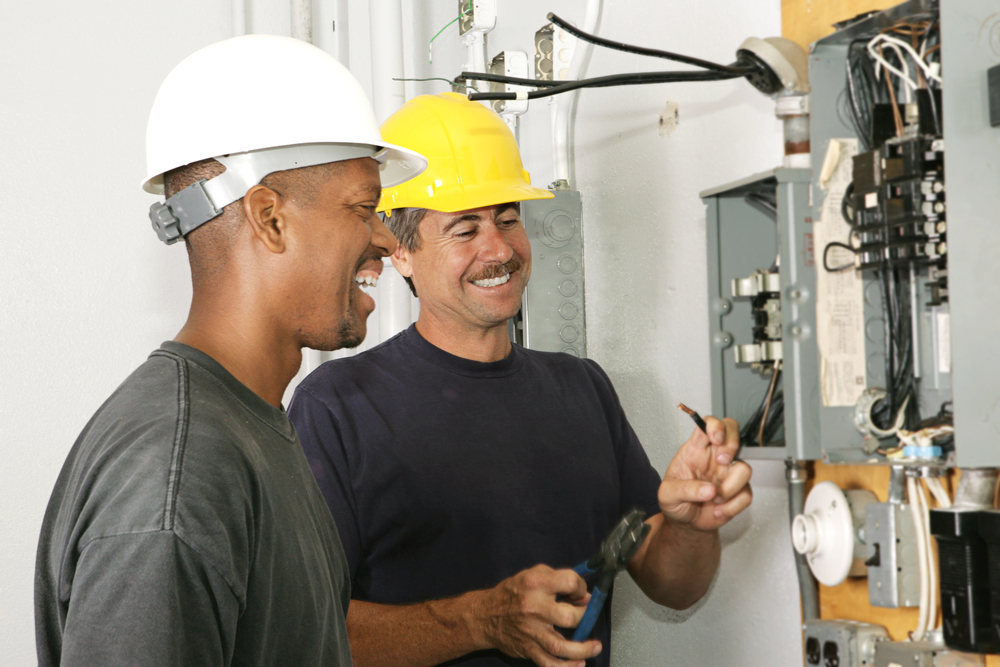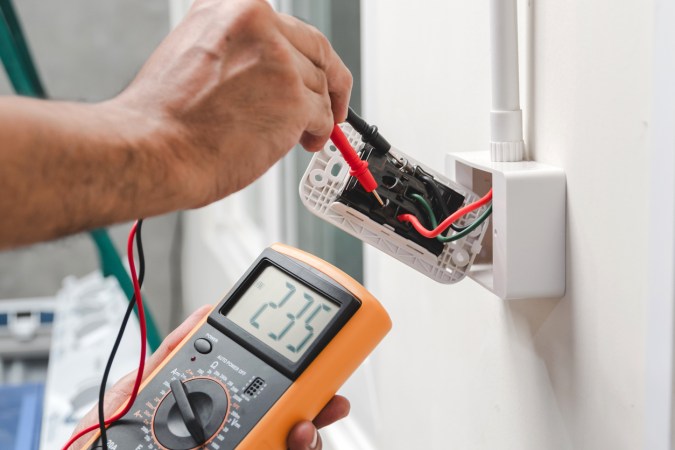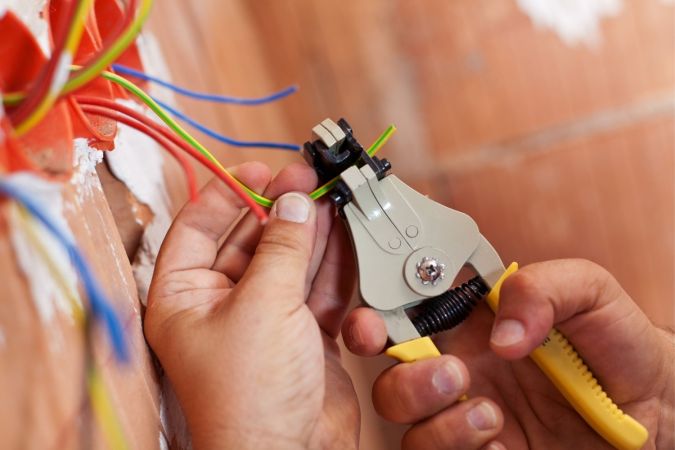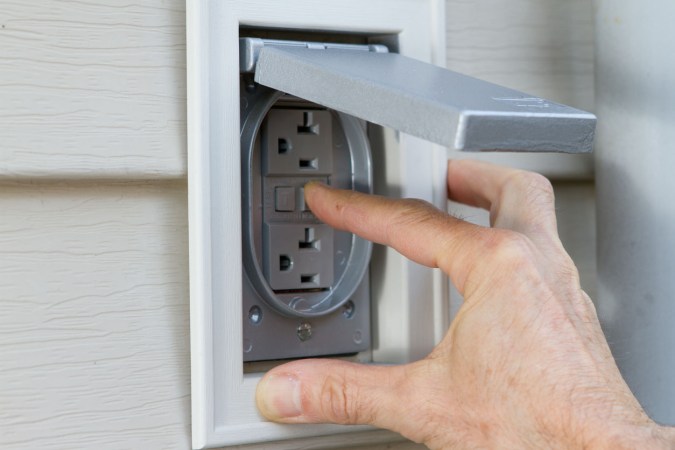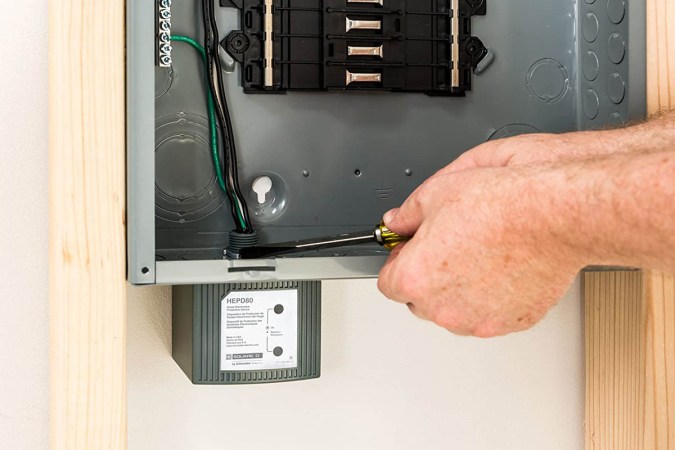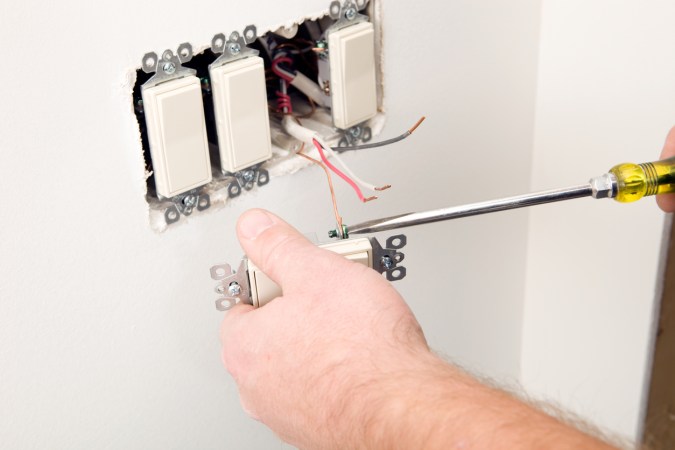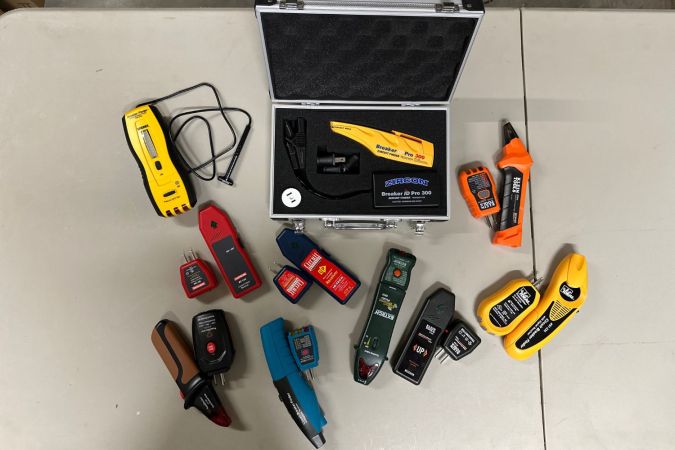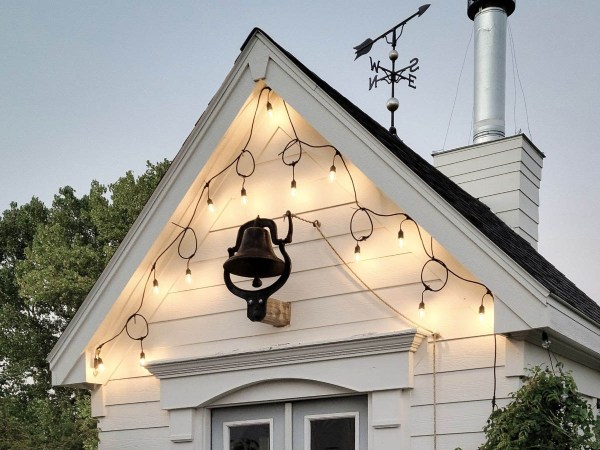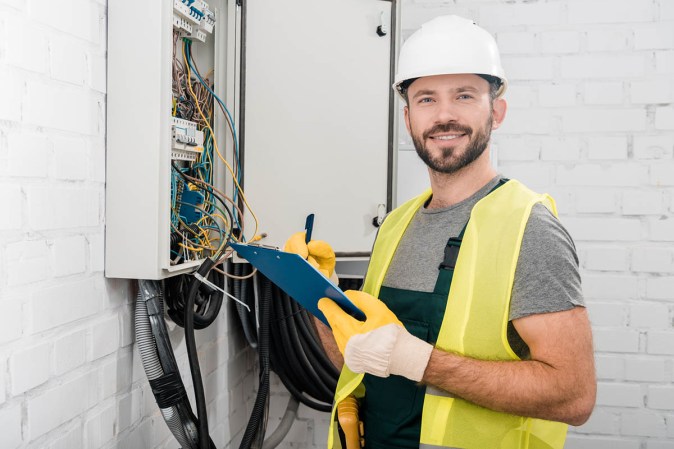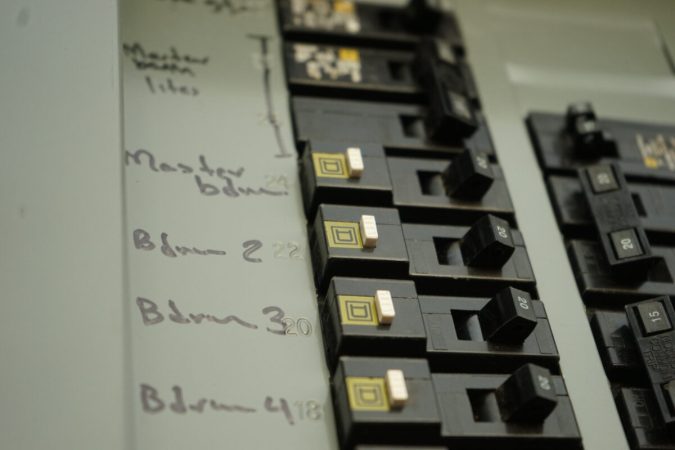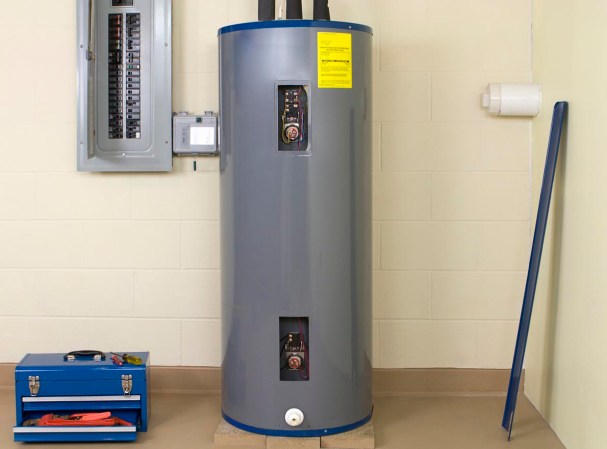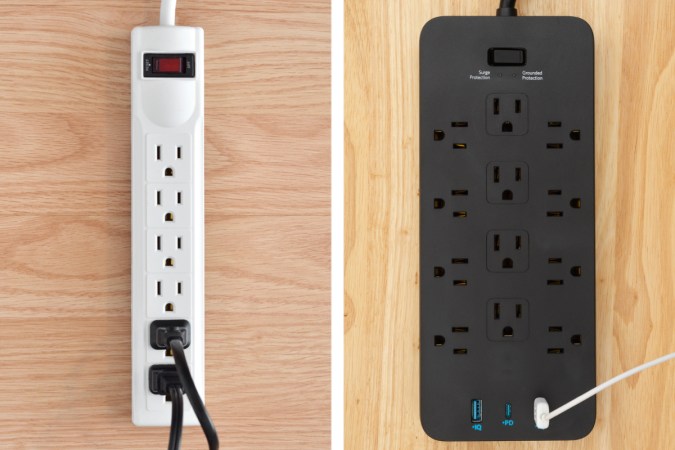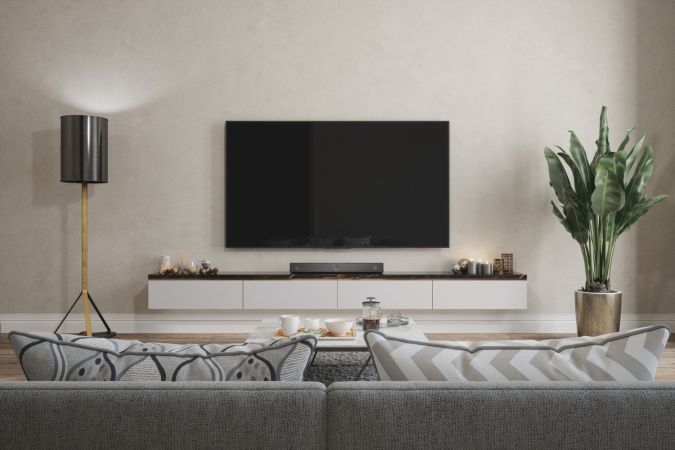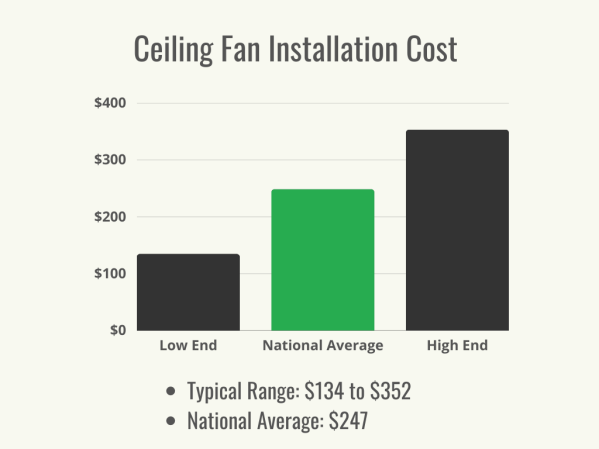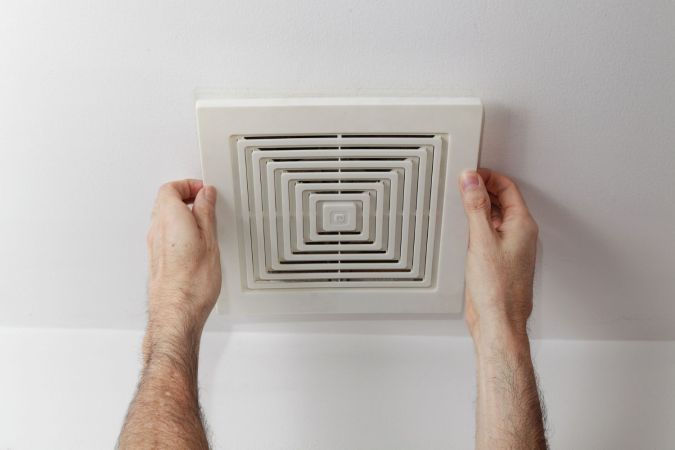We may earn revenue from the products available on this page and participate in affiliate programs. Learn More ›
Highlights
- The typical range for electrical panel replacement cost is $522 to $2,082, with a national average of $1,274.
- The type of electrical panel, its amperage, location, brand, materials, labor and permits, and inspections can all impact electrical panel upgrade costs.
- Electrical panels need to be replaced when they are too old to provide sufficient power, are rusted, produce a burning smell, are overheating, make crackling or buzzing noises, the breaker trips frequently, lights in the home flicker, devices charge slowly, there are too few outlets, the panel has low amperage, the system is outdated, outlet holes are black, energy costs have increased, old appliances are replaced with new, or the current panel is not up to code.
- Replacing an electrical panel is not a DIY project—homeowners will want to hire a qualified electrician to ensure the job is done safely.
n updated electrical panel keeps all the appliances, computers, smart TVs, and gadgets in a house running smoothly. If the current breaker box can’t keep up with the electrical usage in a home, it may be time for an upgrade. And it’s important to note that electrical panels that are 25 to 40 years old are considered a fire hazard and will need to be replaced. According to Angi and HomeAdvisor, electrical panel replacement costs can range from $522 to $2,082, with homeowners spending an average of $1,274.
Homeowners will want to understand how electrical panel costs are calculated, additional price considerations, the different types of electrical panels, and what questions to ask regarding electrical panel replacement.
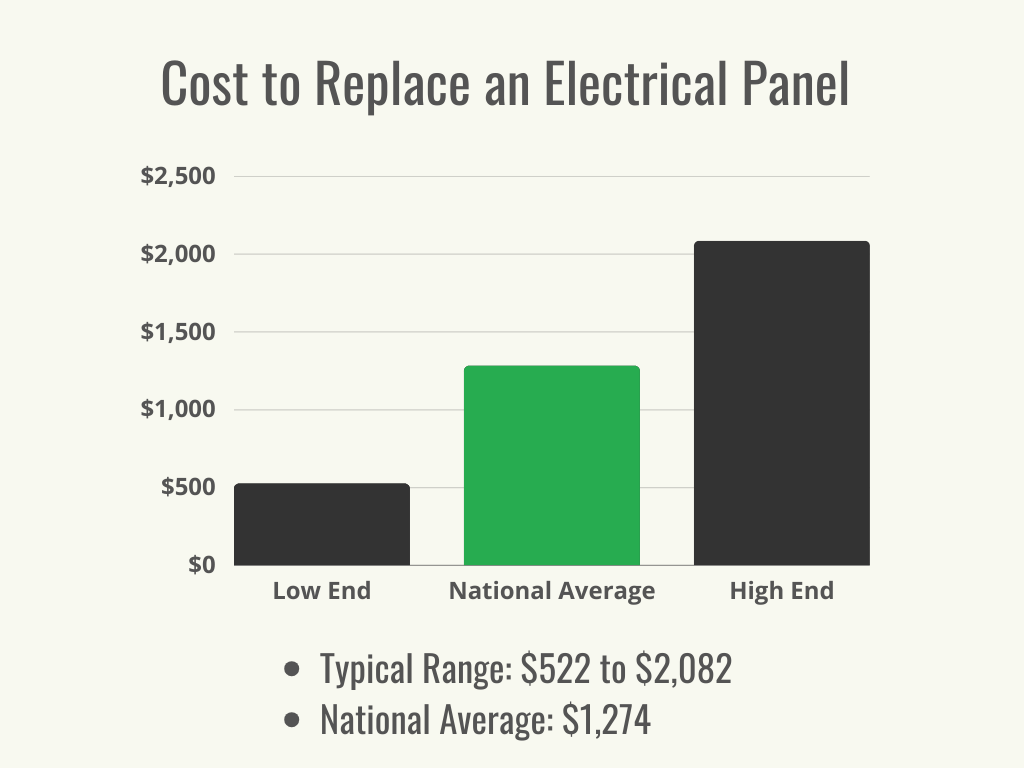
Factors in Calculating the Cost to Replace an Electrical Panel
While the average cost to replace an electrical panel is around $1,274, the final cost depends on several factors. These can include electrical panel type, amperage, location, brand, materials, labor, and permits.
Type
There are a few different types of electrical panels: the main lug panel, the main breaker panel, fuse boxes, and subpanels. The main breaker panel controls the circuit breakers and how much electricity is used within the home. The new electrical panel cost is dependent on what type of panel is needed.
Amperage
For those who are wondering, “How much is a new electrical panel?” a significant part of the cost is determined by the electrical panel’s amperage, or the strength of the electrical current. Increasing the amperage means some of the resistance in the circuit is removed so that a stronger current can flow. Homeowners interested in upgrading to a panel with a higher amperage will first want to check with the utility company to see if the supply line can support additional power. Costs can increase drastically if the power line needs to be upgraded. Here are the prices to upgrade an electrical panel’s amperage.
- 100 amps: In an older home that has an electrical panel with only 60 to 80 amps, an upgrade may be needed to power a modern home; 100 amps is typically considered the minimum amount of amps a home needs. An 80-amp panel can be upgraded by installing a 20-amp subpanel or by installing a new unit within the existing box if it’s big enough. This can cost between $100 to $200.
- 150 amps: Upgrading to 150-amp service costs between $150 and $250. If many appliances run simultaneously or if multiple power strips are in use,150 amps offer more electrical flexibility. A subpanel can be used for an upgrade, but some homeowners prefer to install a brand-new box.
- 200 amps: Larger homes over 1,800 square feet with additions, high energy demands, garages, and multiple appliances operating simultaneously can benefit from a 200-amp electrical panel. This upgrade can run between $250 to $350.
- 400 amps: An upgrade to 400 amps is needed when specialty equipment or electronics need a massive amount of electricity. This can run from $500 or more. This upgrade is typically done with two 200-amp panels installed on opposite ends of the house, and the utility company will need to replace the wiring and meter base. These costs can rapidly rise because of the underground conduit and high labor prices for installation. If the home is more than 100 feet back from the street, the cost to upgrade electrical panel components will be much higher.
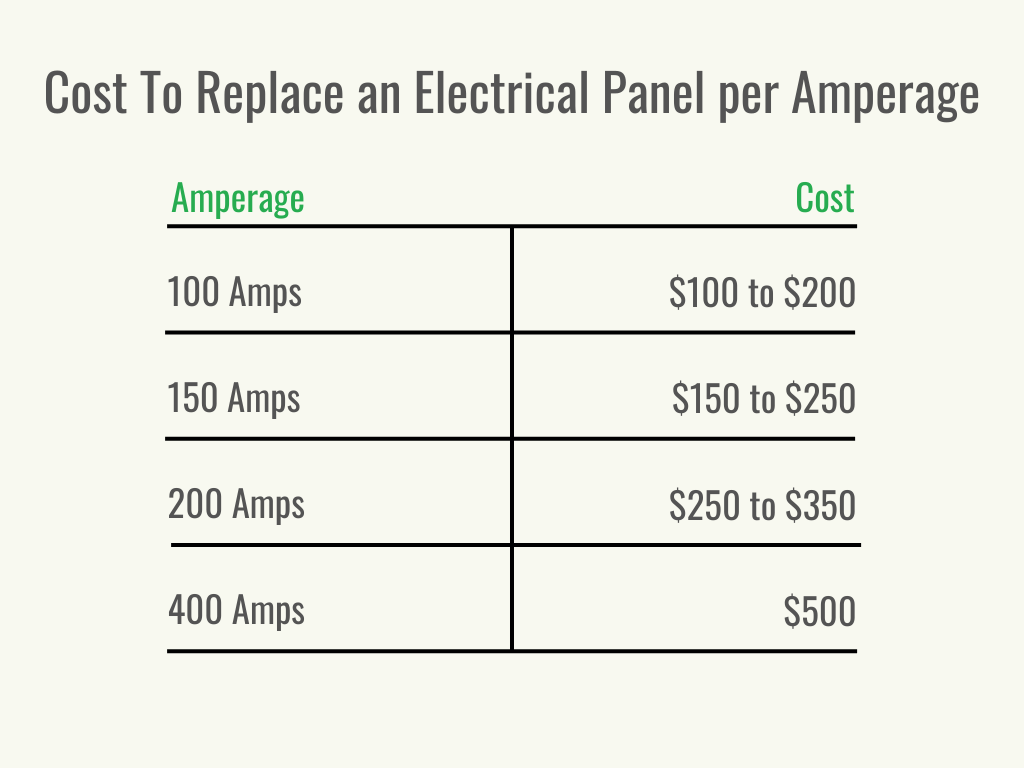
Location
Electrical panels can be located in any area of a home, and a centralized, easy-to-access location is the most beneficial. Moving the electrical panel from one location to another inside the home can cost $1,000 to $3,000. Newer homes may have the electrical panel installed outside the home in a weatherproof or weather-resistant box. This makes it safe and easy to turn off the power during an emergency. If a homeowner wants to move the electrical panel from inside the home to outside, this can cost $1,500 to $2,500 as a complete rewiring will be necessary.
Brand
There are quite a few brands of electrical panels to choose from when deciding on a replacement, and they all have different types of warranties and price ranges. Some of the top electrical panel brands are Eaton, General Electric (GE), Leviton, Siemens, and Square D.
It’s strongly recommended that homeowners who notice that they have a Federal Pacific or Zinsco electrical panel replace it as soon as possible. These panels were installed in homes built from the 1950s to 1980s and do not meet current building codes. They are considered an extreme fire risk when they malfunction because the breakers don’t trip and will start a fire. The same problems have been reported for Challenger and PushMatic electrical boxes.
| Brand | Average Cost (Unit Only) |
| Eaton | $301 |
| General Electric (GE) | $1,180 |
| Leviton | $266 |
| Siemens | $256 |
| Square D | $111 |
Labor and Permits
The majority of the cost of replacing an electrical panel comes from labor. Many electricians charge between $50 and $150 or more per hour. Replacing an electrical panel can take between 20 and 30 hours. If the electrician needs to access wiring inside the walls, labor costs can increase.
Do you need a permit to replace an electrical panel? Yes, and many electricians will pull the permit and add the cost, which is typically between $50 and $300 or more. It’s important to note that changing an electrical panel without a permit can result in major fines. It’s a good idea to double-check with the electrician to see if the price of a permit is included in the estimate or if it will be an extra charge.
Inspection
An initial inspection is necessary for the electrician to determine what kind of work will need to be done to complete the job. This will also help the electrician come up with an initial estimate for the project cost. An electrical inspection costs between $125 and $250, and some professionals will waive the fee if they are hired for the job afterward. Another inspection may also need to be done by the city to check the work, and this expense is typically included in the cost of the permit.
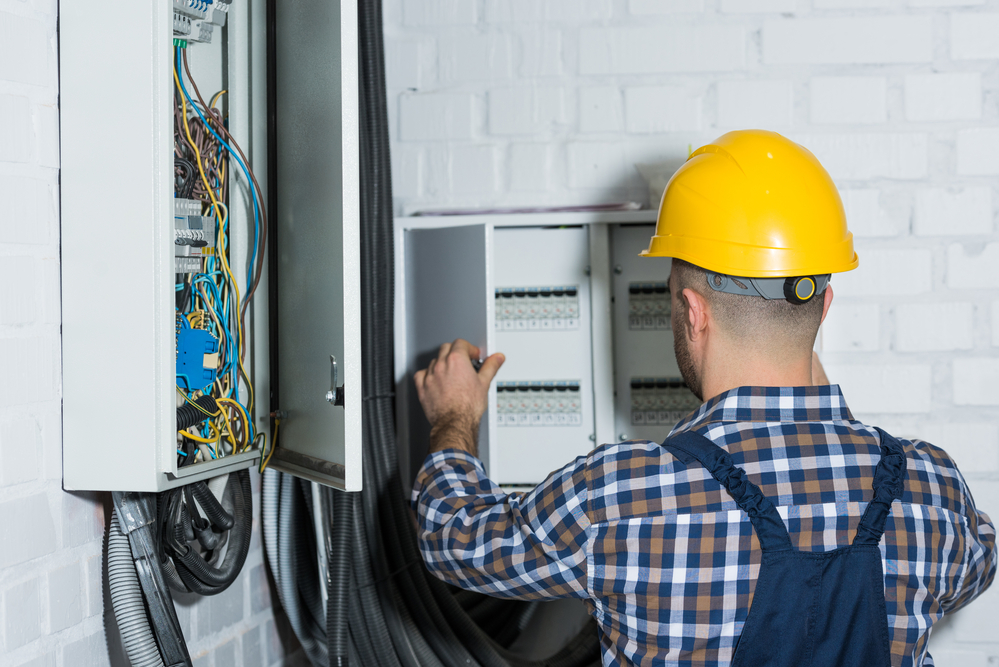
Additional Costs and Considerations
When planning for the cost to replace an electrical panel, it’s helpful to know about any additional costs and considerations. These can include electrical panel relocation, rewiring, subpanel installation, electric meter replacement, fuse box replacement, fuse or switch replacement, trenching, additional outlets, and drywall repair.
Panel Relocation
Moving an electrical panel can run from $1,000 to $3,000. The price can vary depending on the number of circuits, whether the panel is located indoors or outdoors, whether the existing box can be used as a circuit junction, and how many floors the home has.
Rewiring and Grounding
The cost to rewire a house is $12,000 to $20,000, and rewiring an electrical panel can cost from $500 to $4,500 including labor and materials. Replacing just a few circuits will cost less than if the entire house needs to be rewired. A professional will need to inspect the electrical panel to determine the extent of the work. Electrical panels must be grounded as a safety precaution against fire or electrocution. Copper is the most common grounding material and costs around $1.50 per linear foot.
Subpanel Installation
Subpanel installation cost depends on the number of circuits and the amperage. Subpanels have between four and 20 additional circuits, and the amperage ranges from 100 to 150 amps. Homeowners who include an addition to their home or install an inground pool typically opt for a subpanel installation to provide additional amperage and increase the power. The cost to install a subpanel ranges from $530 to $1,940.
Electric Meter Replacement
A new electric meter box costs between $100 to $650 to install, including materials and labor. A meter box is located on the home’s exterior and, as the name suggests, contains the meter. The box will need to be lockable and weather-resistant. It might be necessary to replace an electric meter box if more circuits must be added via a subpanel, if the meter box is damaged, or if the amperage is being increased. Additionally, older meter boxes can contain mercury and will need to be replaced. Newer boxes are usually digital and provide a more accurate reading of electrical usage.
Fuse or Switch Replacement
Replacing a circuit breaker switch can cost between $100 and $200. For 15- to 20-amp switches, the cost averages $5 to $15 each, and 20-amp switches cost between $10 and $20. Older fuses can cost up to $70 and can be challenging to find.
AFCI vs. GFCI Breakers
A breaker is a safety feature on an outlet that will cut the flow of electricity if it detects that something is wrong. Arc-fault connection interrupters (or AFCIs) and ground-fault circuit interrupters (GFCIs) are the most common types of breakers found in a home. AFCIs are designed to detect issues such as electrical shock or overheating that could lead to a fire. They are required in certain rooms of the house like bedrooms and living rooms and cost $50 to $100 each. GFCIs prevent electrocution by detecting water and are required in bathrooms and kitchens. If they do detect a surge, they will cut power, which results in the electrical outlet not working until the GFCI is reset. GFCIs cost $5 to $100 each.
Trenching
Homeowners may opt to bury an overhead line while replacing an electrical panel. It’s important to keep in mind that different professionals are needed to dig the trench and install the wiring. The average cost per linear foot for trenching is $6.
Additional Outlet Installation
Many homeowners choose to add more outlets when they replace the electrical panel. By wiring new outlets, they can save on labor costs by getting all the electrical work completed at the same time. The cost to add an outlet is between $100 and $185 and depends on location, wiring, and if new circuits need to be added.
Drywall Repair
If a wall needs to be opened up to replace wiring or to add outlets or switches, the drywall will need to be repaired or replaced. Installing new drywall costs $1.50 to $3 per square foot. The electrician may include this as part of the job, or it may be necessary to call a contractor to fix the drywall.
Schematic Drawings
A schematic drawing is essentially a map of the various components of a home’s electrical system. Since no systems are identical, this can be of use in the future if changes need to be made for remodels or upgrades. An electrician can produce a schematic for a cost of about $40 to $120 per hour.
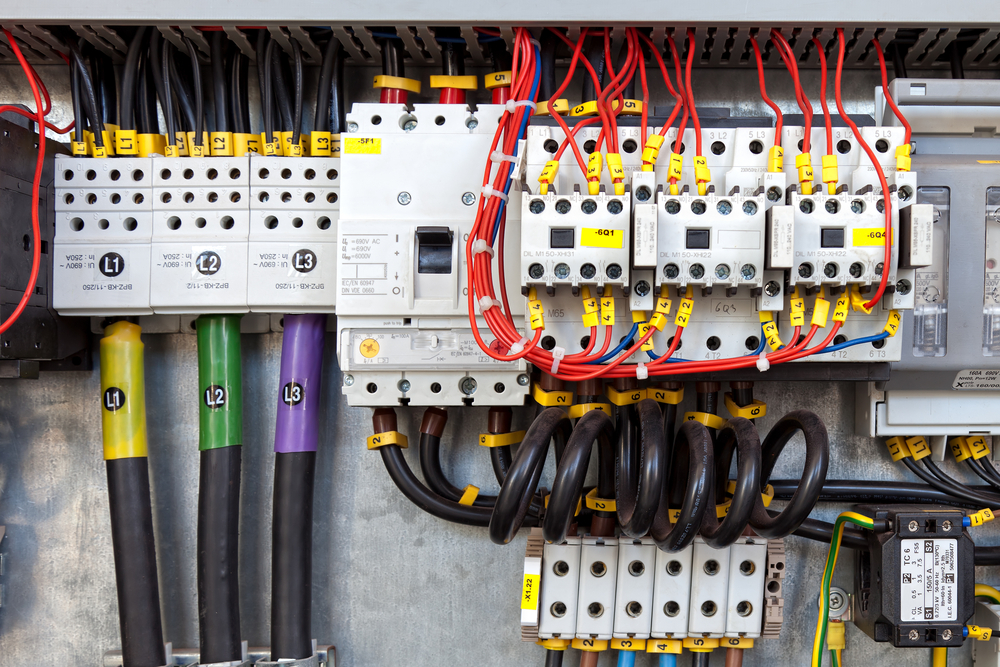
Cost by Type of Electrical Panel
The cost to replace an electrical panel depends on the type of panel that’s needed and how long it will take to install. In some cases, only one electrical panel part will need to be replaced, or it may be time to update the entire system.
| Panel Type | Cost |
| Fuse box | $200 to $2,000 |
| Main breaker | $500 to $2,000 |
| Main lug panels | $400 to $1,750 |
| Subpanels | $530 to $1,940 |
Fuse Box
Fuse box replacement is common to ensure a home complies with the local electrical codes. Typically installed through the 1960s, fuse boxes are less common now. Fuses do the same job as circuit breakers but in a different way: They both block the flow of electricity in the event of an electrical surge that could damage wiring or create a fire. However, a fuse contains a filament wire that breaks when it’s overloaded, and a circuit breaker breaks the current when the switch trips. Fuse boxes were not designed to handle the amount of electricity that passes through a modern home, and installing bigger fuses can increase the possibility of a fire. The cost to replace a fuse box runs from $200 to $2,000. Fuse boxes are often replaced with circuit breaker boxes for safety and convenience, which costs between $1,500 and $2,000 or more, depending on the amount of new wiring that’s needed.
Main Breaker
The main breaker turns off all the electricity in a home at the same time. A main breaker may need to be replaced if it trips frequently, if the switch is hot to the touch, if it’s damaged, or for safety reasons if the breaker is old. It can cost between $500 and $2,000, depending on the amperage and the number of circuits. If a homeowner plans on adding rooms to the house, a subpanel may need to be installed to handle the additional electricity requirements.
Main Lug Panels
A main lug panel, also known as a downstream or secondary panel, doesn’t contain the main breaker—it’s used as a subpanel of the main breaker. When the main breaker has run out of space for additional circuit breakers, a lug panel is installed to decrease the load and act as a distribution panel. Main lug panels cost between $400 and $1,750 to install.
Subpanels
Installing a subpanel can cost from $530 to $1,940. These smaller panels act as a service panel that directs power to a particular area rather than the entire home. A subpanel is a good way to add circuits or additional amperage to a home.
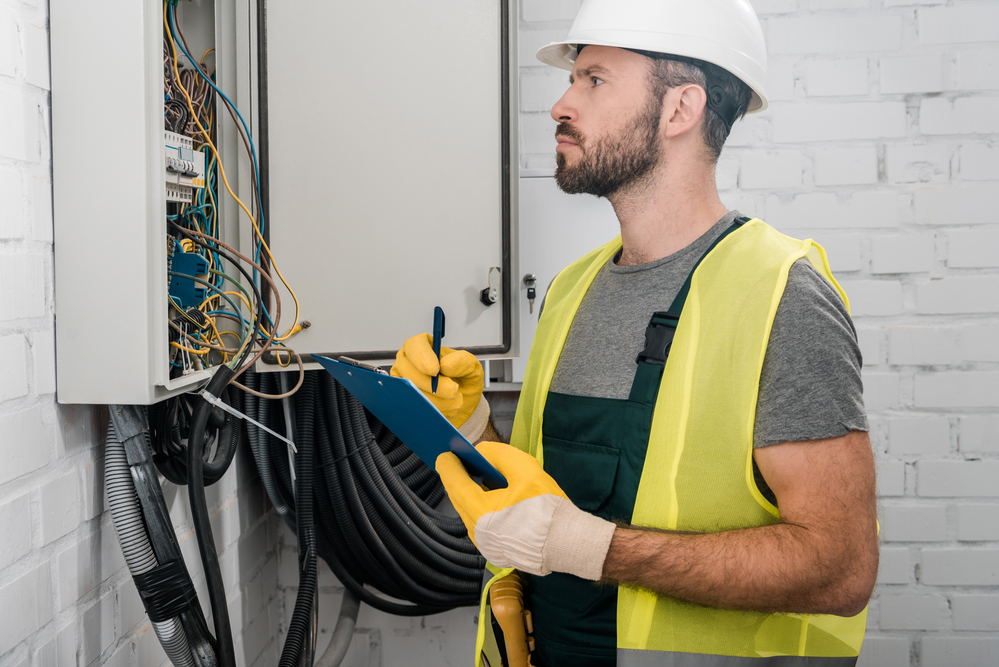
Do I need to replace my electrical panel?
For homeowners who have not received electrical training or attended one of the best online electrician schools, it isn’t always clear when to replace an electrical panel. Replacing or upgrading the electrical panel can fulfill a home’s power demands, improve electrical safety, and ensure the electronics and appliances are working efficiently. If the panel is older or damaged, or if the home experiences frequently tripped breakers, it’s time for an electrical panel upgrade.
Age
Older homes typically do not have the power to run modern appliances and electronics efficiently and may not meet current safety standards or local codes. Older replaced parts can be worn, and circuits can be damaged. Older panels showing the warning signs of dangerously outdated wiring are also a fire hazard.
Rust and Damage
Rust in an electrical panel shows that water has infiltrated the box. Rust and corrosion increase the risk of an electrical panel fire and will make the panel unsafe to use. Any type of visible damage is a sign to replace the electrical panel.
Burning Smell
Loose wiring connections can cause overheating and arcing, which can cause house fires. If an electrical panel is hot to the touch or emits a burning smell, it’s likely unsafe to use and will probably need to be replaced.
Crackling or Buzzing Noises
Buzzing or crackling sounds coming from the electrical panel could mean a breaker is not tripping when it should. This is a sign of wire failure and can result in a house fire.
Frequently Tripped Breakers
If the circuit breakers regularly trip, that’s a signal that the electrical system is overloaded or there is a problem with the panel or wiring. There may not be enough amperage to power the home’s electrical needs, or the panel is undersized. Homeowners may need to look into wiring a breaker box to address the issue.
Too Few Outlets
Using multiple power strips to make up for the lack of outlets can cause the strips to overload. In older homes, it’s common for a few rooms to be on the same circuit, and using power strips can overload the circuit. If an older home has too few outlets, the electrical panel will need to be replaced and more circuits will need to be added.
Low Amperage
Homes with additions or significant electrical usage will need to upgrade to a higher amperage to support the power demand. It’s common for older homes to have lower amperage because they didn’t have modern appliances, computers, electronic devices, or central air conditioning to power. If electrical devices seem to be charging more slowly than usual, or lights are dimming or flickering, these are signs that an underpowered electrical panel isn’t meeting the power demands of a home and needs to be upgraded.
Black Outlet Holes
Brown or black marks around outlet holes are a sign that they’re getting too hot and are overloaded. This is when a professional needs to be called in to replace them and assess the wiring in the entire house.
Increased Energy Costs
If a homeowner notices that their electricity bill is increasing without their current usage changing, an electrician can examine the power usage and make sure the wiring and electrical panel is in good condition. Replacing or upgrading the panel could result in lower electricity bills in the future.
Upgraded Appliances or Systems
An undersized electrical panel may need to be upgraded to accommodate new electrical appliances that have a higher power demand. Using new appliances without recognizing the power demand needed could result in frequently tripped breakers and overloading the panel.
Local Codes and Regulations
It may be necessary to replace an electrical panel to be in compliance with local codes and regulations. Electrical panel installation and placement is regulated by building codes intended to prevent fires. Professionals will follow an electrical inspection checklist after the electrical panel replacement to determine if the installation meets the codes successfully.
DIY vs. Hiring a Professional
Given the costs of this job, it’s natural to wonder, “Can a homeowner replace an electrical panel?” However, it’s vital to note that replacing an electrical panel is a serious and potentially hazardous job. Even if a homeowner has access to the best electrician tools, without professional training and know-how, this is not a suitable DIY project. A licensed professional will be the most qualified person to replace an electrical panel and any wiring that’s needed for the job. Electricians know how to replace electrical panels in accordance with local codes and safety requirements to guarantee the installation is done properly and safely. Attempting an electrical panel installation without knowing the difference between electrical wire colors or how each component functions can result in incorrect wiring and loose connections, which could result in extensive repairs or a house fire. It’s common for insurance companies to not cover any damage to the home if an electrical panel was installed by an inexperienced homeowner. Homeowners can search online for “electrician near me” to find a local contractor and to read up on electrical safety tips if they plan on doing some of the work themselves.
How to Save Money
Budgeting for the cost to replace an electrical panel can be daunting, and the additional fees associated with the project can quickly add up. One way to save money would be to hire the cheapest electrician available, but there are other ways to save without compromising on quality.
- Get multiple quotes. Get quotes from at least three reputable electricians in your area.
- Bundle renovation projects. If you’re renovating your home and need an electrician to add outlets or wire a new addition, replacing the electrical panel at the same time can lead to discounts. Ask your electrician if adding a replacement project would save money on the overall cost.
- Consider replacing the meter box. Replacing the meter box at the same time as replacing the electrical panel can save money on labor costs.
- Let the electrician buy the supplies. Professional electricians have contacts that allow them to get better deals on electrical panels and supplies. They can buy the parts for less than the average homeowner and can pass along the savings.
- Saving energy is saving money. By replacing an outdated electrical panel, you can save money by using the proper amount of energy for your home.
- Replace only what’s needed. If the wiring is in good shape, replacing circuits instead of rewiring the entire home can save money. If it’s recommended that the entire house needs to be rewired, don’t skimp. Replacing wiring can prevent overloading and house fires.
- DIY what you can. If you’re experienced with drywall patching and repair, tackle that part of the job on your own. Paint walls yourself instead of hiring someone else.
Questions to Ask a Pro
Asking a professional electrician the right questions about electrical panel replacement can minimize miscommunication and maximize savings. Below are some questions to ask about electrical panel replacement.
- Are you licensed and insured?
- Do you have references?
- How much does it cost to replace an electric panel?
- Do I need a whole panel replacement?
- Do I need a permit to upgrade my electrical panel?
- Will you take care of the permit process?
- How does the inspection process work?
- Do you offer any discounts for bundling electrical projects?
- How long will the replacement take?
- Who will install the replacement panel?
- How long will my house be without electricity?
FAQs
Staying within a budget for electrical panel replacement can be challenging. Below are some frequently asked questions about electrical panel upgrades to help guide these decisions.
The cost to upgrade an electrical panel from 100 to 200 amps runs from $750 to $2,000. New wiring and additional circuits will increase the overall cost.
An electrical panel should be upgraded and replaced if:
1. The original panel is more than 25 years old.
2. There aren’t enough outlets in the house and you’re using multiple power strips.
3. You’re planning on adding new appliances and need more power.
4. You’re constructing additions and adding new electrical systems.
Your electrical box may need to be replaced if you notice flickering lights, discoloration around outlet holes, or damage in the electrical panel. If you’re planning on adding appliances or if you have an old fuse box, you may also want to upgrade or replace your electrical panel.
It can cost between $500 and $4,000 to get an electric panel installed in a new house. If the electricity lines are close to your home, connecting them may be free, but the cost can range from $25 to $50 per foot.
It can take from 4 to 8 hours or more to replace an electrical panel.
Angi, HomeAdvisor, Fixr, HomeGuide

